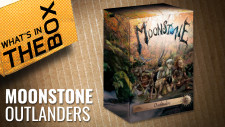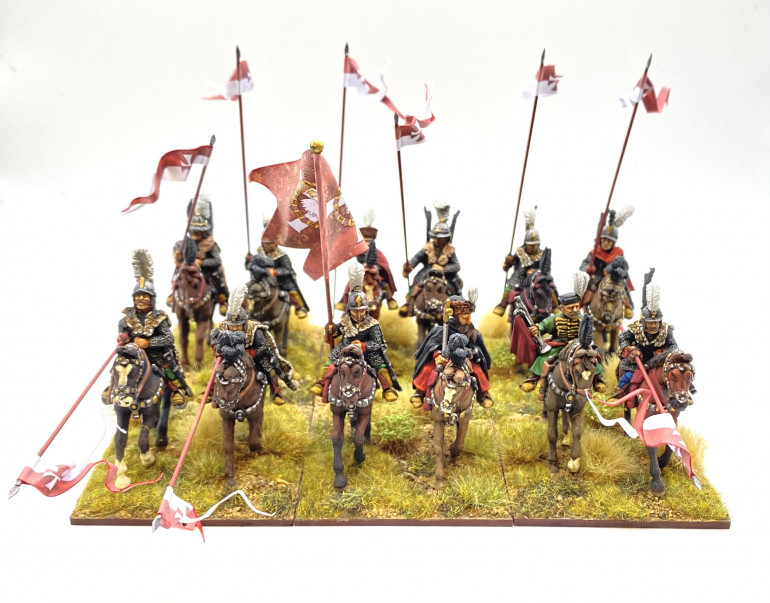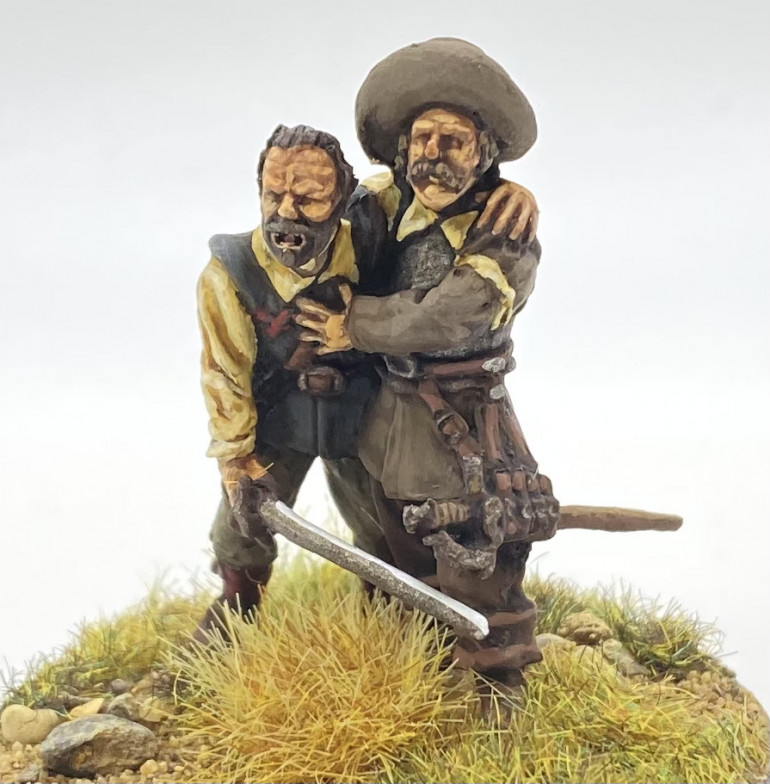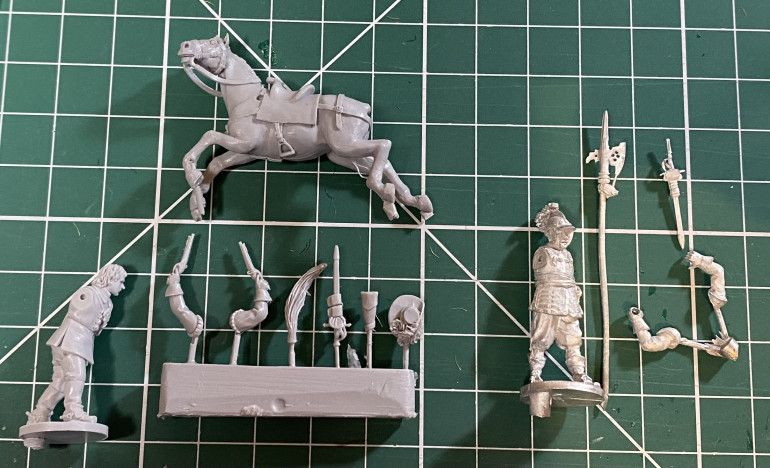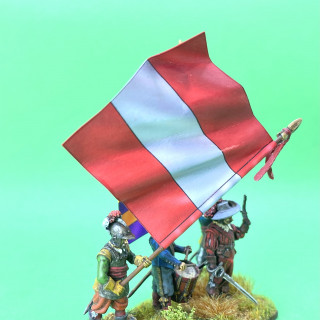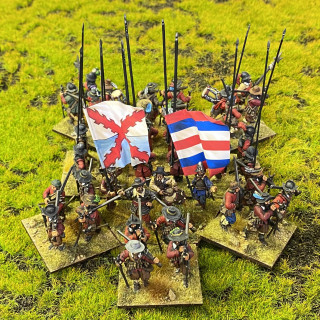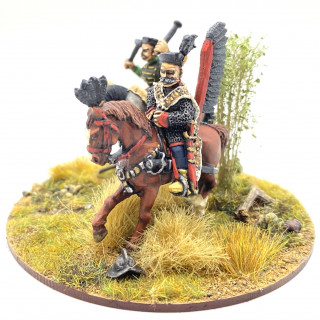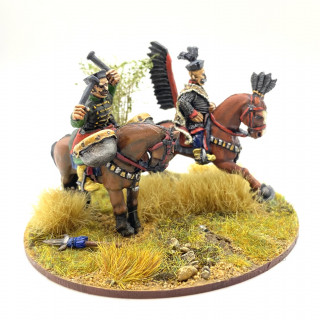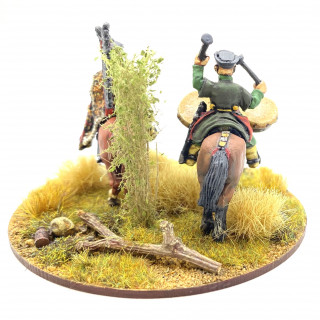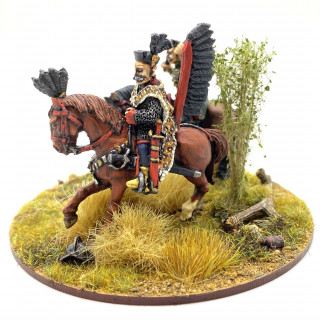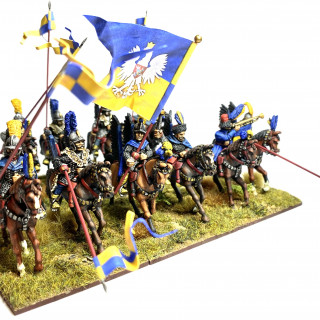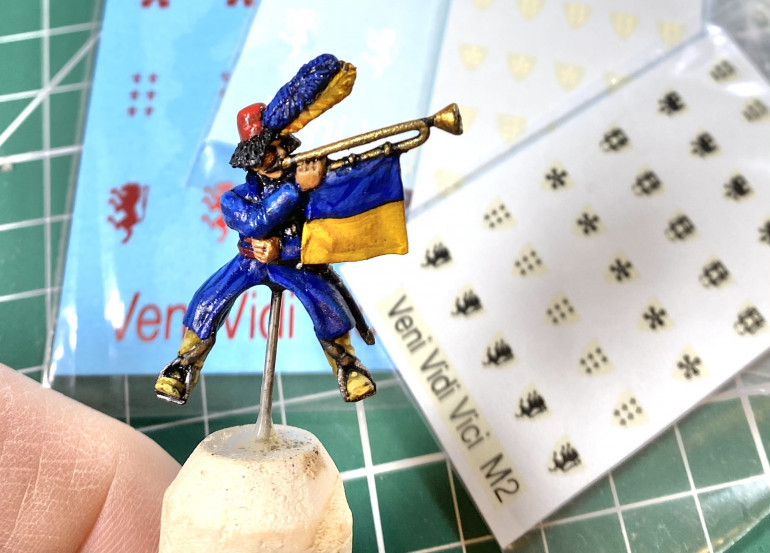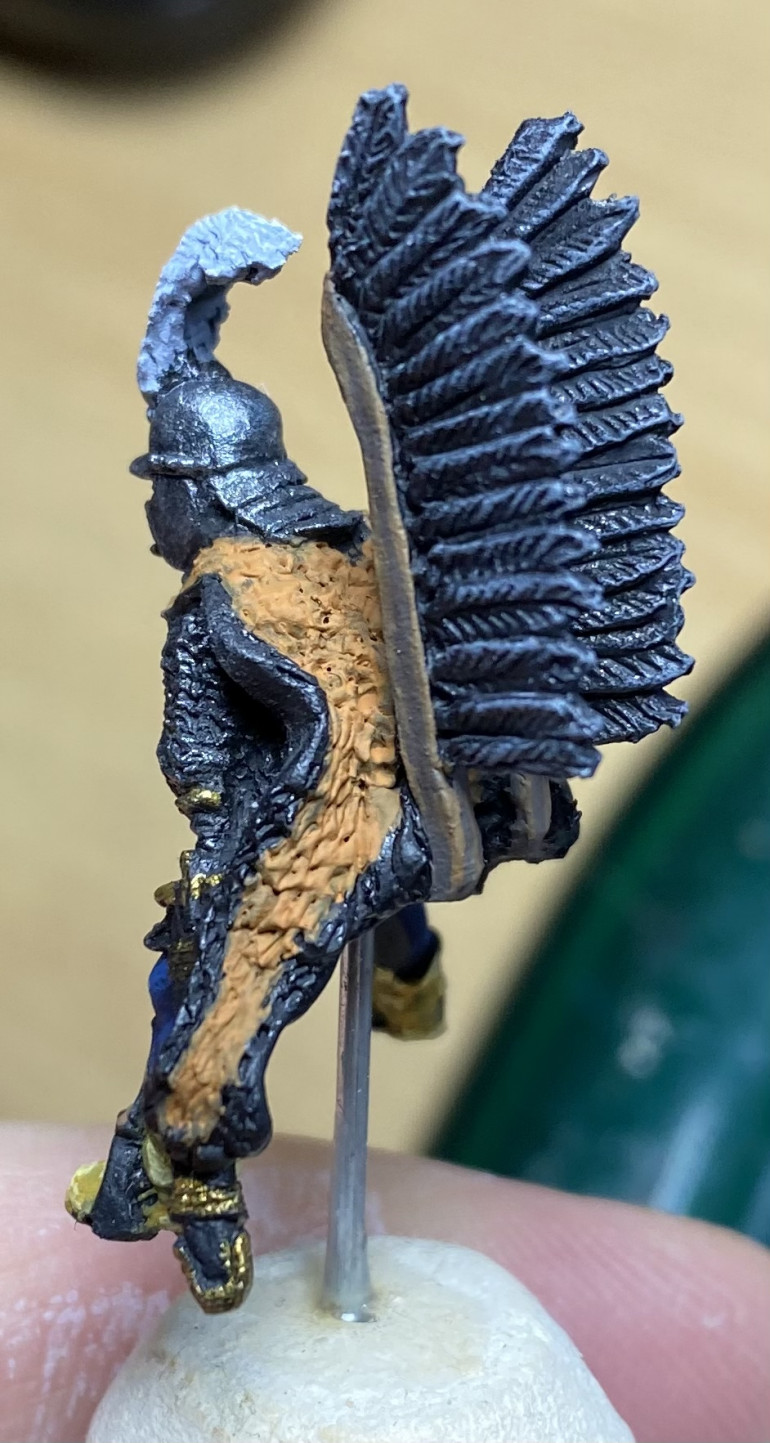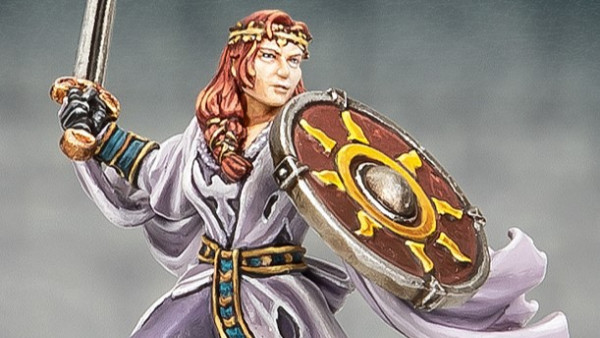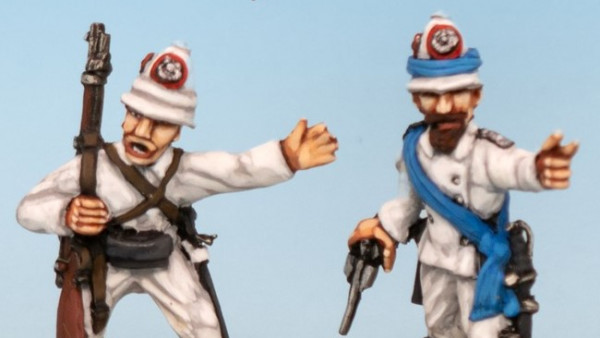
Husaria – Building a Polish army for the 1620s
Recommendations: 2003
About the Project
This project describes my efforts to build a 1620s Polish and Lithuanian Commonwealth army, including the famous Polish ‘Winged’ Hussars. I will cover the historical research, choosing the miniatures, build and painting the miniatures, and finally hopefully playing with the army. (N.B. Since starting this project I have added a couple of further projects to the system. One contains opponents for the Poles, the Swedish army. I had been adding entries about these here but it was a perhaps bit confusing. See here for the Swedish project: https://www.beastsofwar.com/project/1798825/ . I also started a project for the set up a of demo game planned for Salute 50, using the Poles and Swedes, here: https://www.beastsofwar.com/project/1798842/ .)
Related Game: Pike & Shotte
Related Company: Warlord Games
Related Genre: Historical
This Project is Active
From The Ground Up - Part 4
THIS CONTINUES THE BASING WALKTHROUGH FROM THE 3 PREVIOUS ENTRIES
Step 7.
I leave the base for an hour or so for the PVA to start holding the green stuff. I then prune any tufts or static grass that are hanging over the base edges with small scissors. This helps prevent problems with getting bases to sit tidily next to one another.
The final job is to tidy the base edges. These have often become messy with the application of filler, PVA and sand. I like a nice dark brown finish for the base edge and a fast way I have found to do this is Posca paint pens (available in some Hobbycraft stores in the UK or try Amazon).
The based unit is now ready to take its place in the growing miniature army. I use this approach for 15mm (perhaps using smaller tufts) as well as 28mm. It is not the quickest method, but I like the end result, and I have honed down the steps over the years to make it is as efficient as possible. (The paint in the PVA was a major step forward!)
I had no idea this was going to take 4 project entries to complete! Sorry about that ;-). To make up for this, here are some pictures of the latest figures for my Polish army, all based up. First is the unit of Polish ‘Winged’ Hussars. These are 28mm with riders from The Assault Group (TAG) and Wargames Foundry. The horses are all TAG. Flag and lance pennons from Battle Flag.
 Here is another commend base for my ‘Foreign Infantry’. These are from 1898 Miniatures’ Tercio range, except the drummer who is from Horcata Miniatures. Flags are from Flags of War.
Here is another commend base for my ‘Foreign Infantry’. These are from 1898 Miniatures’ Tercio range, except the drummer who is from Horcata Miniatures. Flags are from Flags of War.Phew! Until next time.
Andy.
From The Ground Up - Part 3
THIS CONTINUES THE BASING WALKTHROUGH FROM THE TWO PREVIOUS PROJECT ENTRIES.
Step 6.
The final step is my favourite of the basing process, and is when the base comes ‘alive’ with the adding of static grass and tufts. I like to see this as the gardening phase! I use two different colour tones of static grass as a base. One mid-tone, with dull mid-greens, and some lighter browns, and the second a dark-tone with dark greens and dark brown, both using 2mm static grass. I buy small bags of static grass, from all sorts of suppliers, and mix them up myself for the mid colour. I find mixes described as ‘Autumn’ work quite well as they have more muted colours. My mid-tone grass evolves slowly over time as new lumps of static grass are mixed in to the mid-tone container. The dark-tone is more straightforward as I use straight Army Painter Steppe Grass which has a nice variety of colours straight out of the box.
My overall approach for the grass and tufts is variety. Before the use of pasture improvers, such as nitrogen post WW2, natural grass land was incredibly diverse. In the UK it is actually very difficult to find examples of what original, native grassland would have looked like. The mono-culture, bright green fields we are used to seeing nowadays are not representative of what a battlefield would have looked like 100+ years ago. I am therefore aiming for a variety of natural colours and textures in the greenery on the base, but without taking too much from the figures themselves.
I also tend to vary the tufts I use. I keep finding new suppliers with interesting colours etc. I use 4mm, 6mm and 10mm tufts. Currently I’m using tufts from:
- Warpainter (available on Amazon)
- World War Scenincs (WWS)
- Green Stuff World
- Tajima
To apply the green stuff I use slightly watered down PVA, added to the sandy base with an old brush.
First I add the mid tone static grass which will be the largest volume of green cover. I have a careful look at the base first, looking for any areas where the sand mixture doesn’t look so good, or perhaps the figure base is more obvious. I make sure these areas are covered in static grass to cover up any imperfections. I apply random patches of the thinned PVA and then add the mid tone static grass. I add the static grass on thickly and press it in to the PVA with tweezers. I make sure I leave around four nice flat areas to accommodate tufts later. After pressing on the static grass I invert the base and tap firmly with the tweezers on the bottom of the base until the excess is off. This also helps the grass stand-up a bit. (Probably not as much as an electrical static grass applicator would, but I find the tapping method easier.)
With the mid tone static grass applied I then repeat the process to add a few, smaller patches of the darker tone of static grass next to mid-tone.
There should now be a few spots left without static grass and to some of these I add tufts. I will use a variety of three or four types of tuft for a single unit, with one or maybe two of each type per base. Although the tufts come with sticky bases, I add some PVA to the sandy area before pressing on the tufts with tweezers.
I leave some patches of the highlighted sand showing, including the areas of the larger bits of sand, as this adds to the variety and interest on the base. \
BASING CONTINUES WITH STEP 7 IN THE NEXT PROJECT ENTRY
From The Ground Up Part 2
THIS CONTUES AT STEP 3 FROM THE PREVIOUS PROJECT ENTRY
Step 4.
On top of this PVA and paint mixture, while it is still wet, I apply sand. I bought a 5Kg (roughly 10lbs) bag of builders’ sharp sand 30+ years ago and I suspect I will never need to buy any more! I sieve the sand (using the kitchen sieve – don’t tell the chief!) to separate it in to a fine sand and bigger bits (see picture below).
On top of the wet PVA + paint mixture I apply one or two small (one pinch) sprinkles of the larger bits of sand. This gives a bit of variety to the overall texture of the base.
With one or two patches of the larger bits added, I then cover the rest of the base in the finer sand. I tend to sprinkle this on by hand, fairly thickly, and then turn the base over and gently tap off any excess sand, which is reclaimed for further basing.
Step 5.
The figures’ cast on bases should now be disguised / hidden, and the whole base should have a nice rough, realistic texture. The sand provides a subtle variety in colour that works as an accent to the earth / mud coloured paint underneath. The base now needs a good amount of time to dry and I typically leave them overnight to make sure everything is really dry and firm.
Although I like the earth + sand colour, it needs a highlight to add contrast, and also to tie all of the colours together. I have found a single, light dry brush with Vallejo 917 Beige works well.
Dry brushing sand is very tough work for a brush and they do not last long in this job. As the sand has provided a colour change from the base earth colour I think a single highlight is fine at this stage.
CONTINUED WITH STEP 6 IN NEXT PROJECT ENTRY
From The Ground Up
In this blog entry I describe my basing approach and also share some of the latest units of the painting table.
I thought some people might be interested to see my basing method. Even if you have a well practiced basing approach already, hopefully there will be some tidbit of interesting / useful information in the seven steps described below.
Step 1.
I paint figures separately and, once they are painted and varnished, add them to the final base. Normally this is 2mm MDF from Warbases. I typically use Bostick adhesive, or something similar, as it is relatively cheap and readily available.
Step 2.
Once the figures are on the base, and the glue is dry, the next step is to try and disguise the metal or plastic base the figure is cast with. For this I use filler / spackle. I add a few drops pop water to make the stuff easier to apply, but don’t add too much as the filler will lose its ‘shape’ and will not hide the metal/plastic base. I have found a couple of tools that make this easier. One is from a collection of artist’s plastic palette knives, readily available on Amazon/eBay. I also have the GW basing tool to help me get in to smaller gaps around the figures’ feet (but you can easily use an old brush if you want to). These tools have a bit of flex and are great for applying thick or textured stuff like filler.
This is a rough and ready stage. The key thing is to go around the metal / plastic based that the figure is on. No need to cover the whole base as that will be done in a later stage. The more bumps and splodges the better as this helps add an uneven surface to the overall base.
(If you accidentally get some filler on the figure then a brush with water on can be used to wash it off.) When the bases have had the filler applied then it is best to give them some time to dry before the next step. An hour or so should do (it doesn’t need to be fully cured, just mostly dry).
Step 3.
With the filler on, the next step is add more texture, this time over the whole base, with sand. To fix the sand I use a mixture of PVA, acrylic paint and water. You need to add enough paint so that the PVA ‘whiteness’ has taken on almost the complete colour of the paint. Then add a small amount of water, enough to make the PVA+paint easy enough to apply thickly with a brush, but not too much to over dilute the PVA so it will not hold the sand. My preference for paint colour is Humbrol Matt 29, Dark Earth. Nothing else is quite the same, but it is just a personal preference so you can use what you like. (I have found the Dark Earth works well with the sand I use in the next step.) The PVA and paint mixture is then painted over the whole base quite thickly. I tend to use old brushes for this job. I use a small brush first to go around the figures’ feet, and then a bigger brush to fill in the rest.
ACTIVITY CONTINUES IN THE NEXT PROJECT ENTRY
Casualties of War
One piece of record keeping that is required for Pike and Shotte games is to keep a note of a unit’s loss of stamina points. You can do this with a small dice, but I find that these either get knocked over as figures are moved about, or that the dice get picked up by accident and used for other rolls! I am therefore a fan of using these counter bases from Warbases (link). I have used here the 40mm “Style 2” option. These are ideal to fit a 28mm figure which I think improves the look of a bare counter.
I was therefore delighted to see that 1898 included a ‘Dead and Wounded’ pack in their Tercio range (link). Having recently painted up a few units of shot from this range these casualty figures were ideal to use with them on the tabletop. In line with the rest of the range, the casualties are single piece, 28mm castings, some of which require the addition of a scabbard to the figure.
There are six figures provided in the 1898 Dead and Wounded pack, although two of them are provided as a single piece casting. I really like the poses of the figures as there are two or three that provide a nice change from the standard dead figure lying flat on the ground. I really like the wounded solider being helped by his comrade, and the wounded officer preparing to defined himself.
The figures were nice to paint up, and have enough detail to take washes. 1898 have a useful painting guide for the Tercio range on their site (link) that, as well as showing the overall technique, also has a handy table of the Vallejo colours that provide the ideal muted colour palette to represent the typical 17th century solider on campaign.
I hope you have found this project entry useful, and you feel inspired to create some of your own casualty markers.
Until next time!
Those Bloody Miniatures!
This entry takes a look at minis from a new figure producer, Bloody Miniatures.
Bloody Miniatures (link) is a new figure producer that has just released (March 2021) their first range of miniatures. These are aimed at the War of the Three Kingdoms (English Civil War) and the Thirty Years Wars. The initial release contains four packs, each of four different figures and is focused on equipment and poses especially suitable for forlorn hopes, storming parties and other smaller ‘actions’. The figures have been sculpted by Nick Collier, who Bicorne and Renegade fans may remember was the designer for those early ranges. In common with Bircorne etc. these are on the larger side of 28mm figures, and are supplied in one piece metal castings (the figures armed with pole arms have separate weapons).
I was lucky to spot the announcement of the Bloody Miniatures range on Facebook on the release day. I was so impressed with the pictures that I immediately ordered all four packs. The figures arrived in a couple of days and were very nicely boxed. I especially liked the red tissue paper used in packing which goes well with the company name!
The figures are really nice sculpts, with lots of crisp details. This initial release are great representations of dismounted cavalry and infantry equipped for close quarters fighting. This makes them ideal for smaller skirmish games, or as specialist assault units in larger games. I have chosen to make some slight conversions to the first four on to my painting table as a command group.
The ensign with the red colour (above) is supplied with a polearm, so I have simply swapped this for a flag. I added a drum from my bits box to the carbine armed figure to represent a musician who has slung his instrument and is getting ready to get stuck in. I didn’t change the sword and pistol armed figure. The ensign with the yellow colour has had his, previously empty, left hand drilled out to accept a flag staff, and I also added a hat, also from my spares box, as he was bare headed and I wanted a more formal look. (Flags from Adolfo Ramos, link.)
I based these figures on individual, round bases, as I intend to use them in either skirmish games or as lose formation troops in games of Pike and Shotte. I normally use UK two pence pieces (2p) as bases for this type of figure as there are the perfect size, the weight helps balance metal figures and they are magnetic for helping with storage. Due to ‘the event’ I no longer seem to have a supply of 2ps. Over the last 12 months I have used up my own stock, as well as raiding the children’s piggy banks etc. I have therefore fallen back on Warbases round, 2mm deep, MDF bases with a 5mm hole (link, and then go to custom items to order the holes link). Warbases do these in exact 2p diameter size, which is great, and with the addition of a 5mm diameter, 2mm deep rare earth magnet, the bases are also magnetised for storage.
You can see from above that I’ve also taken this a step further. Warbases made me some custom 2p movement trays, also with holes for 5mm magnets. These are 70mm in diameter with space for three bases. These are a great way to add some flexibility to your collection; you can use figures individually when necessary, and also multi base for convenience. Two tips. You can get different size magnets but I have found 5mm the best to allow for the weight of a 28mm metal mini. Secondly, when using magnets in the tray, and on the figure base, then polarity becomes important. When gluing the magnets in you’ll need to check that the polarity matches with the rest of your collection. I keep one of my completed and magnetised bases handy to use when deciding which way round the magnets need to be placed in new bases.
In conclusion, this is a fantastic start from Bloody Miniatures. The figures are a joy to paint; very characterful, and with clear details. There are a few figures wearing triple bar lobster pots that I will probably restrict to representing troops in the British Isles, but the rest of the figures would be at home in any conflict in the first half of the 17th century. I understand that the first release was so successful that the initial stock sold out in a couple of days! There has since been a re-supply and I would heartily recommend these figures to anyone using 28mm figures in this period. A new release is planned for later this year, and I am really looking forward to it – I’m sure it will be something out of the ordinary, and very desirable!
Flogging a dead horse (Avanpost part 2)
Following on from my last update, I have completed some more of the Avanpost miniatures.
Above is the completed mini diorama for the stamina counter base. I realise this is perhaps a rather morbid scene, but it’s a good reminder of how horses suffered in this period of warfare. I’m glad that Avanpost chose to include this in their collection so we don’t forget this point.
I have also purchased an artillery piece from Avanpost. The gun carriage is in resin and you can choose to have the gun barrel in either resin, or beautifully turned brass! These brass gun barrels are little works of art. I will probably paint over this, but it does provide the option of just weathering the bare metal for you finished model.
I have just two cautions that you should consider with the Avanpost figures. Firstly is that the resin is reasonably delicate and so when there are small parts that stick out on the resin figures I have found them prone to breaking when not carefully handled. For example, the scabbards are very fine items, and a couple of times, when I have carelessly picked up a resin figure, I have broken their scabbards. These are fairly easy to repair, but if you expect to be rough with your figures you should beware of this.
The second item is, I suppose, both a plus and a minus. Wargames figures from other manufacturers have traditionally been sculpted with parts of the figure slightly exaggerated; for example heads, hands and weapons. This has been partly to do with what we think looks good, and partly to do with traditional sculpting and casting methods. The Avanpost figures, on the other hand, seem to be very accurately sculpted from a scale model point of view, and this is apart of their appeal. This scale accuracy includes their equipment and this means that when you compare an Avanpost figure to say, a Perry or Warlord figure, the Avanpost figures’ muskets appear to be much finer and smaller than those on other manufacturers’ figures. Variety in figure height is ok by me (real people are different heights) but differences in equipment scale can be incongruous. For example, I would be nervous of fielding Avanpost musketeers with musketeers from other manufacturers in the same unit because of the different musket sizes. I know that actual 17th century muskets did vary in size, but there is only so much difference my eye will accept. I would suggest you get a sample of two to compare with other figures to check for yourself.
In summary, Avanpost offer a range of beautifully sculpted miniatures, some of which are unique to this period. If you are interesting in playing games in the first half of the 17th century then I’m sure there is a space in your forces for some of these miniatures! The range is still expanding with the recent release (in resin) of sword and buckler armed infantry.
The final pictures show the command base with an also newly completed 1898 unit of musketeers.
Until next time!
Avanpost Miniatures - a mini review (part 1)
This entry covers my experience with the Thirty Years Wars (TYW) figures from Avanpost Historical Miniatures.
I first became aware of this company a couple of years ago from posts on the Lead Adventure Forum, and I was instantly blown away by the quality of their figures. They are superbly detailed and lifelike. I immediately ordered a few figures to see what they were like in the hand, and I wasn’t disappointed.
Avanpost are a Russian manufacturer and don’t have a traditional website/shop. They use a Facebook group to advertise their ranges (link). You can also buy them through Mezzer’s Miniatures (link), a UK distributor. They have two main 28mm ranges; Napoleonic (French & Russian) and Thirty Years War (TYW). They also produce a range of really lovely 75mm models for collectors and painters. Their full ranges are available in cast resin, and most of the 28mm ranges are also available in metal. They are on the small side of 28mm and fit perfectly with Perry Miniatures ECW range. I have mixed them in happily with TAG and Warlord as well. However they might seem a bit incongruous in the same unit with Bicorne or Renegade which are at the bigger end of 28mm.
Most of the figures require some assembly, such as adding arms and sword scabbards. I assume they are designed like this to make the casting process easier. The figures I received have needed little cleanup and fitted together very easily, whether metal or resin, with small dabs of super-glue.
I have only purchased figures from their TYW range so far. Unusually nowadays, the figures are sold individually which is a real boon when you are trying to find that extra drummer figure, or officer, for example. They cover pike and musket armed troops in a wide variety of classic poses. They also cover artillery (guns and crew), dragoons, harquebusiers, and cuirassiers, with command figures for all types. The TYW range is pitched at the first half of the 17th century and would work equally well for the Wars of the Three Kingdoms (ECW).
Here are a couple of figures as they arrived from Mezzer’s Minis. On the left is a resin wounded horse and dismounted cavalryman (an unusual and perhaps unique to Avanpost set!), and on the right a metal sergeant with halberd. The separate pieces were easy to snip from the sprues, and to tidy up with craft knife and file before assembling with superglue.
Here is the wounded horse after construction. This is on a Charlie Foxtrot ‘dial counter’ base and will be used. as stamina / wound counter in Pike & Shotte games.
Here are a group of resin and metal foot figures after construction. Hopefully the picture shows the fabulous level of detail in these figures, both resin and metal.
Here is a completed command base using figures from the previous picture. The figures were a joy to paint. (One caution would be that the figures, both metal and resin, could do with a quick wash in warm soapy water before priming. )
The flags are from another supplier new to me, Adolfo Ramos (link), who is based in Spain. These are really nice flags, and there is a lot of flexibility available when ordering to choose the size of flag you want, and also to have them mounted with cords etc. I chose this ‘full service’ option for these two and was very pleased with the result.
In the next post I’ll finish off my review.
Until next time!
Commanding Bases
In this project entry I’m going to cover basing the command groups for the infantry in my army.
Background
Up to now my foot units have typically had one base within the unit that includes the ensigns or standard bearers. In a period with either no uniforms, or what uniforms there were being vaguely understood now, it is often the unit’s flags that gives the strongest indication of what the unit is trying to represent. Also, I think flags look really good and so try to have two of them in most units. Along with the two standard bearers I typically include an officer and musician (most often a drummer) on the base. The officer’s sash can also suggest a particular historical force (although not as often as we’d hope). Therefore you can see that by changing this single command base you can swap the unit for use in a different army.
My basing system for foot figures is to use four 28mm figures on a 40mm square base. This system, with my approach to command bases, means that three bases makes a nice central pike block; two bases of pikemen either side of a central command base. The full regiment or battalion therefore looks like this.
New Requirements
More recently I have been looking at representing formations that don’t fit this approach, such as the Swedish brigade formation that Gustav Adolph used for his Swedish infantry. I’ve also been looking to experiment with other rule systems, some of which use the whole unit frontage as a measure in the game, that means this 360mm (9 bases each of 40mm width) wide formation isn’t very convenient. If I was able to have the command base outside the regular rank and file bases then it would make it easier to change units about.
A solution to this was suggested when I looked at some of Barry Hilton’s units on the League of Augsburg site (link). Barry sometimes uses a base that sits in front of the rank and file bases. I have seen he has used half hex shaped bases in some cases, and I think this looks quite neat. So, a brief email exchange with the ever helpful Warbases resulted in me receiving some half-hex 2mm thick MDF bases. These are 80mm point to point.
Here is my first new style command base. These figures are from 1898 Miniatures ‘Tercio’ range. The flags are slightly modified from Flags of War.
This base can be placed at the front of a unit. The idea is that it doesn’t count as part of the actual unit for the purposes of the game – it is just there for show.
The pictures show some different formations demonstrating how the new command base will fit in. I think it provides a flexible way having different formations and still have the command base ‘look right’. It can even be placed behind units to allow for the unit to be in combat.
I am pleased that this experiment seems to have worked out. I will build my command bases like this going forward. I want to try it in some games (when we can do those again!) and if it still seems like a good idea then I will consider going back and rebasing some of my old units.
Until next time!
Painting the Foreign Infantry
The metal figures were fairly straightforward to prep. One slight pain was having to glue on the troops sidearms, a sword hung on the left hip from a baldric or belt. These look really nice on the figure, but I’m a bit worried about robustness in the long term as the swords are very thin and stick out in a realistic, but easy to bend way. If you expect to be heavy handed with your figure then you should consider leaving the swords off.
I gave the figures my normal, black spray primer undercoat. I then painted up a test figure to try out how I wanted to paint the figures. I combined a couple of approaches to try and speed up my normal snail’s pace painting speed.
After the primer was cured I gave the figures a very heavy dry brush in Vallejo Flat Brown (70.984). This helps show up the details on a matt black figure, and, as so much of a 17th century soldier ends up brown, this can provide a base coat for things like shoes, belts, bandolier, scabbard, musket, etc.
I painted up a base coat across the other, non-brown items, not being too precious about neatness as minor errors would be corrected by the next stage. Next I gave the figure a generous wash of GW’s Agrax Earthshade (the ‘magic part’). This provides a shade and also neatens up the figure overall. When this wash was dry I highlighted the original base coats again.
This gave a nice impression of what I think a 17th century soldier on campaign might have looked like. (This approach combines techniques I’ve learnt from Matt at Glenbrook Games and also Sonic Sledgehammer.)
With the test figure done, I moved on to the rest of the unit. I used a fairly muted set of natural colours for the rest of the unit. Here they are, all based up. Front rank giving fire, and rear rank loading. A sergeant, with halberd, commands the unit.
I really enjoyed painting these 1898 figures, and I’m pleased with how they came out. I have another 2 x 12 figures to do, before moving back to the mounted part of the force. I am also working on some command stands for the Foreign Infantry, and should have some figures from another smaller manufacturer to show.
Foreign Infantry
In this entry I’m going to cover a new part of the Polish-Lithuanian Commonwealth army; the Foreign Infantry. Although cavalry were the most important part of the Commonwealth armies in this period there was an increasing focus on infantry. Any campaign involving sieges, as well as the need to hold settlements and river crossings, needed foot troops. In the campaigns against the Swedes in the 1620s, Polish forces found that they were involved in many sieges, as the Swedes would often avoid pitch battles in the open where the Polish cavalry could dominate.
The native Polish infantry, drawn from the peasant population, were effective but few in numbers, and the Polish nobility were reluctant to further reduce their work force by allowing more recruitment from the peasants in to the army. The Commonwealth therefore turned to hiring infantry from other sources, typically abroad. This ‘Foreign Infantry’ was recruited from across Europe but mainly from the German states to the West of the Commonwealth borders, and also from German speaking parts of the Commonwealth. (For this reason they were sometimes referred to as ‘German Infantry’.)
Recruitment of the Foreign Infantry worked in a similar way to the rest of Europe at this time. A colonel was commissioned to raise a certain number of troops and it was then the colonel’s responsibility to find suitable candidates. There were no uniforms as such, and so the recruits would be dressed in their regular ‘western’ clothes looking very much like the typical foot troops in the rest of Europe.
One difference may well have been the composition of the troops recruited. It was typical in this period to recruit infantry as one third pike armed troops, and two thirds shot, armed with a musket. One of the primary roles of pikemen was to protect the shot from cavalry. In the Commonwealth forces, with their superior cavalry, pikes were considered less necessary. In the 1620s campaign there is no evidence that the Foreign Infantry were armed with pikes, so it is possible that they were just musket armed troops.
For my Commonwealth army, based on the force at the Battle of Dirschau in 1627, I need some units of Foreign Infantry. I could just re-use some of my existing Thirty Years War Imperial foot to represent the foreign infantry, but I have plenty of potential candidates in the lead pile. I decided to paint up some figures from the 1898 Miniatures ‘Tercio range’ that have been accumulating in my lead pile since their release in 2019. These figures are a great representation of the typical foot from across Europe in the 1620s, 30s and 40s.
Here is link to the 1898 Miniatures site link, and also to a review of the figures I wrote for Wargames Illustrated link. In summary, I really like them! They are really characterful figures, and give a great impression of the typical non-uniformed troops from the TYW, wearing a mixture of styles and types of clothing. If you are interested in getting some of the 1898 figures then you can buy directly from them in Spain, or go to Empress Miniatures who are a UK stockist (here).
Next time I will cover painting the figures.
High Command
This time I’ve been working on another command base for my Polish-Lithuanian Commonwealth. This will be the overall commander for the battle of Dirschau, 1627, Stanisław Koniecpolski.
At this time the Commonwealth had two overall army commanders, appointed by the Sejm (the Commomnwealth parliament of nobles). The most senior was the Crown Grand Hetman, and the junior post was the Field Hetman. In 1627 the Crown Grand Hetman position was vacant, and Stanisław Koniecpolski was the Field Hetman (he was promoted to Crown Grand Hetman in 1632). He had risen quickly to this exalted rank and was also a very experienced general.
TAG produce a great looking Hetman figure, holding a ceremonial mace or ‘bulawa’, that was a symbol of a Hetman’s position. I used this figure to represent Koniecpolski. I painted him to mainly match the outfit in this portrait, although I jazzed up his zupan (long, top coat) a bit.
To accompany Stanisław Koniecpolski I thought of including a standard bearer on the command base. I have done this on other command bases before, especially when the historical general I’m representing has a known personal standard. I hadn’t seen this mentioned for Polish generals but was lucky enough to get a question answered by the super helpful, Michał Paradowski, the author of the recently released Despite Destruction, Misery and Privations. Michał explained that Polish generals in this period did not use flags, but the Hetman in command of the army would have a ‘Hetman’s Sign’ or ‘znak hetmański’ (see Wikipedia description here link.) This was only used by the overall, senior Hetman commanding in a campaign.
Above are a a couple of exerts from 19th century paintings that suggest what the Hetman’s sign might have looked like. These are the best I had to go on as I haven’t been able to find any more details of what exactly made up the Hetman’s sign. The sign is shown as a long spear or lance, featuring a small ‘wing’ of feathers, and a small disc below this. There may be streamers attached to the disc. Some pictures show a small sphere on the lance point, similar to what is used for some flags’ staves. (It seems that later on in this period the feathered wing was replaced with a horse-hair tail.)
I’ve not seen a Hetman’s Sign produced by a figure manufacturer yet. Based on the limited information the sign seemed fairly straightforward to scratch build. I decided to use a hussar lance as the basis for my Hetman’s sign. To make the disc I used a small piece of green stuff and moulded this on to the lance. For the feathers I used an off-cut from a hussar wing that seemed to match the illustrations above. This was filed to fit, and then super glued to the lance between the disc and the point. I then used some paper to make the streamers and glued these on to the lance just above the disc. Finally I glued a small bead to the lance point. I then painted up the model sign, with plenty of gold adornments.
The finished Hetman’s Sign will make a nice distinctive addition to Koniecpolski’s base.
To accompany Koniecpolski, and a mounted figure carrying his Hetman’s sign, I have included another mounted kettle-drummer, this time from TAG. I went for very dark coats for Koniecpolski’s followers to match his cloak colour, and this hopefully helps the great man stand out more in his bright red zupan. With items of debris to add to this base in a similar way to the previous base I was done.
With two command bases done I can be sure that I’ll have generals ready to lead my Polish-Lithuanian forces to battle. I’ll need at least one more command base at some point, so I will need to think of some more ideas for suitable figures.
The next items on the painting table for the Poles are a step down in the hierarchy from the mighty Husaria and noble commanders. Next up is some Foreign Infantry, and I’ll be using figures from a manufacturer that is completely new to me.
Command
When building previous armies I have often fallen in to the trap of getting all of the troops ready and then finding I have no generals to command them when I come to play the first game with the army. To prevent this I decided to jump in early this time with some command bases. There are plenty of images available to provide ideas and inspiration for Polish-Lithuanian leaders, and I’ve included some in this post.
To provide figures for my command bases both Foundry and The Assault Group (TAG) have some nice Polish command packs. I have used some of these figures in my hussar units, but have also kept one or two for the generals and their followers. I typically build my command bases with a small vignette of figures on a round base; three figures on a larger base for the overall general, and two figures on a smaller base for subordinate commanders. I’m following this approach again for my Polish-Lithuanian army, that is recreating the army that fought in the battle of Dirschau in 1627. The following describes the first command bases I’ve constructed.
The first base is for one of the subordinate commanders at Dirschau, Marcin Kazanowski. He was a very experienced soldier and leader, and was in his mid sixties by the time of the battle of Dirschau in 1627. In a long military career he had fought against all of the Commonwealth’s enemies; Ottomans, Cossacks, Tartars, Muscovites and of course the Swedes. I thought that the old Hussar commander that I converted slightly to match the WRG cover (see my first Hussar post) would be ideal to represent him. I also found a picture of a hussar officer that looks like he may have been the inspiration for the WRG cover.
The illustration above is taken from a very useful source for dress and equipment in this period. It is from a 16 metre long picture which shows the parade that took place to celebrate the marriage of King Sigismund III Vasa in 1605. (Link.) This contemporary picture (painted sometime in the early 1600s) is very useful as it shows Polish hussar and foot units marching in the parade, as well as all sorts of nobles, therefore giving some ideas for military attire, and what my generals might look like. A degree of caution is needed as the picture shows a parade and might not 100% represent what was worn on a battlefield, but it is a starting point.
Next I needed a second figure for Kazanowski‘s base. Figure manufacturers seem to be very keen on producing mounted kettle-drummers for the Poles, and these do often feature on contemporary paintings, including the Stockholm Roll. I thought these would look a bit odd in the front rank of my charging hussar units, but would be a nice bit of ‘character’ to add to a command base.
My Foundry Kettledrummer, despite not having the drum banners (perhaps taken off prior to battle?), would fit perfectly for the this command base. To finish off the command base I had a rummage in my bits box for some ‘battlefield debris’. I think the challenge with this is to be subtle without any detail becoming totally lost. I’m never sure if I’ve got this right or not.
Here is the finished command base for Kazanowski.
More Husaria!
With the transfer, from the last project entry, done then it was then time to glue riders on to the horses and get on with the basing. Once again, I used 50mm wide by 60mm deep and 2mm thick MDF bases from Warbases. (Each base takes two horses.) The basing technique was the same as on the previous unit; filler/spackle to hide the figures’ bases, brown paint and pva over that, with sharp sand sprinkled on to the wet pva. Once the pva was dry, a dry-brush of beige on the sand, and static grass / tufts to taste.
So, here is the second unit finished. (The eagle eyed will have spotted that there is a base of two figures missing due to a miscalculation in figure purchases. This has been rectified!)
With two units done I have had to restock my lead mountain with more hussars. Next on the painting bench will be some command bases (and the missing base of two for this unit).
Yellow and Transfers
I’ve not really found a yellow, to use over a black undercoat, that I’m super happy with in the Vallejo or Army Painter ranges. I’ve tried using Vallejo Ochre Brown, as a base for yellow, and built up from that. This is ok, but I wondered if I should look at some other ranges. I have been slowly getting more into the GW Citadel range of paints. I already really like the various shades such as Agrax Earthshade, and have been really pleased with some of the red base + layer combinations. They is a handy app called ‘Citadel Colour’ which helps translate from actual colours to sets of base, layers and shades from the (strangely named!) Citadel range. From the app I found Averland Sunset as a base, with Cassandra Yellow as a shade, and then Yriel Yellow as a layer. I bought this set of paints and I have found they work really well. I also tried some of the Citadel metallics. I must say that, despite the bottle’s pot design (rather than being in dropper bottles), the paints that I’ve tried so far have been really nice to use and I’ve become a bit of a convert!
After painting the figures I brushed on a gloss varnish as a protective layer for the riders, horses, and the lances. As mentioned the lances were getting a set of Battle Flag pennons. The main unit standard is blue and yellow, split horizontally, with a white eagle in the centre. I decided to repeat this on the trumpeter’s trumpet banner, that is cast on the figure. The two colours was fairly straightforward, but the white eagle would be tricky. A Google search threw up some potential transfers that looked like they could work from Vene Vidi Veci. VVV do sets of 15mm and 28mm ‘medieval’ heraldry symbols that can be ordered in a variety of colours. I ordered sets of 15mm and 28mm from Magister Militum (link) in white, black and red. I ordered both sizes as I wasn’t sure how big they would be and wanted to make sure that they would fit on the trumpet banner.
Once I had the transfers I decided that the 15mm size transfer would work best on the trumpet banner. I haven’t used transfers for a long time and decided to give this fancy Micro SEL and Micro SOL stuff, made by Microscale, a try. The figure was already gloss varnished, which is apparently the best base to start transfers from. I cut out a small, white, single-headed eagle transfer from the VVV set and, using a pair of tweezers, dipped it in water for a few seconds. While the water was soaking in to the transfer, I painted a small amount of Micro SEL (from the blue bottle) on to the trumpet flag where I wanted the transfer. The transfer was now loose after its short soaking and so I slid the transfer off its backing and positioned it on the banner with the same brush I used for the Micro SEL. The Micro SEL allowed me to move adjust the position of the transfer with the brush tip. When it was in the right spot I smoothed it down with a small amount more of Micro SEL. After repeating this for the back of the trumpet banner, I set the the figure aside to dry.
Once the transfer was dry I painted a small amount of Micro SOL on top. As the banner was a fairly flat surface this last stage, meant to mould the transfer on to curved / uneven surfaces, was perhaps not necessary, but I wanted to try out the full process. I left the figure to dry once again. The flag design that I was copying for the trumpet banner has a small red shield over the eagle’s breast, and a yellow crown on the eagle. At this scale, two blobs of colour, were good enough approximation of this design for me! I‘m sure many people would have managed with some white paint to approximate the eagle, but the transfer was a neat way of getting a consistent result on both sides.
Hussar blues
Trying to keep up momentum I’ve moved on to another unit of Hussars. This unit is made up of a mixture of The Assault Group (TAG) and Foundry riders, as before, but this time on TAG horses. The TAG horses are nice clean sculpts and most have some fancy feathers etc. which are very suitable for the noble Hussars, who liked an ostentatious display. They also have a single pistol holstered on the right side of the saddle. This is a nice touch as firearms were becoming popular with the Hussars in this period. I’m not so sure about carrying only one pistol, but I expect someone out there knows if this is right?
I’ve added wings in twos, or singles, to most of the figures, but left some without. In this unit the wings are attached directly to the horse, rather to the equivalent position on the rider figure. As covered in the previous posts, I have decided to have wings ‘saddle mounted’ (rather than fixed on the rider’ backs) in ones or twos as limited to the richer / more showy individuals in the unit. The wings are a mixture of the TAG wings and the Foundry wings modified to be the straighter, earlier type. The TAG horses have a slot modelled at the back of the saddle to take wings. The Foundry riders needed some chipping and filing to make them fit in the TAG saddles and I had to keep riders and horses matched during the painting process so I could be sure of them fitting together at the end.
Although not always strictly historical, I like to have a colour theme for my units. For this unit I had chosen a blue and yellow flag, with matched pennons, from Battle Flag. I therefore decided to carry on this blue and yellow theme to the horse trappings, and also the Hussars’ cloaks and helmet feathers. I chose to use a few different hues of blue to add some variety while keeping within the overall theme. I used Vallejo’s Prussian Blue, Ultramarine, and Pale Dark Blue, and then shaded / highlighted each of these. I also wanted to include red on the hussars as this was a popular colour with wealthy Polish nobles in this period.
Fanfare!
To complete the unit I followed my normal basing approach. The figures were glued, two figures to each 50mm wide and 60mm deep, 2mm thick, MDF base, from Warbases. The bases were then covered in an earth coloured paint and PVA glue mix, and sharp sand sprinkled on to the mixture while it was still wet. Once the paint-PVA mix was dry it was dry brushed with a beige colour, and then static grass and tufts were glued on with more PVA.
With a final fanfare of trumpets my first unit of Hussars was completed!
It feels pretty good to have the first unit done. I realise that I have made a bit of a ‘song and dance’ over one unit of cavalry, but I really enjoyed putting it together, and trying out some new techniques. I’m also pleased that the unit looks like I’d hoped it would, and should give a good impression of a 1620s Hussar formation.
Next in the painting queue is another unit of Hussars. I look forward to pushing through a bit faster on this one, using all of the lessons learnt on this first unit.
Sticks and Flags
 Lances made using 80mm brass spears (from Warlord) and with a small bead added to each. Undercoated with black spray primer.
Lances made using 80mm brass spears (from Warlord) and with a small bead added to each. Undercoated with black spray primer. With the horse and riders just about ready it was time to move on to the Hussars’ primary weapon, the lance, or “kopi”. These are typically shown as painted red, often with patterns. I decided to keep the lances red, but fairly plain, with just a small detail on the hand guard. (I will try to work up to stripes etc. for future units.) I painted and varnished the lances separately before attaching them to the figures. One of the striking features of the hussars are the brightly coloured, swallow tailed lance pennons. I bought some sets of these from Battle Flag (link). I cut these out with a modelling blade and then glued them on to the lances. I use good ol’ Pritt for my flags.
With all of the components ready it was time for the final steps. Glue the riders on to the mounts, matt varnish over the complete model, and then gluing the lances on to the riders. It was great to finally add the lances; the figures seemed to come to life with the lances in their hand
Animal Print
One item on the figures that was a ‘first’ for me was the animal pelts. These were very popular for the wealthier Hussars, and leopard skins seem to have been most popular. It was not unusual to make fake leopard skins by adding spots to pelts from other animals. I had never painted leopard skins before and so I resorted to searching YouTube for a suitable tutorial. I found one (https://youtu.be/NjcvsaKIhWU) which was nice and straight forward, and I was quite pleased with the result. Here are the steps I used. (All colours are from Vallejo Model Color range.)
I was quite pleased with the result. At a wargaming, arm’s length, distance it looks like a good approximation of a leopard skin, although I don’t think it would fool a real leopard. On the basis that many of the cloaks worn by the Hussars were ‘fake’, this might actually be a point in my favour!
Any colour as long as it’s black
I also like to use a black undercoat on 17th century cavalrymen as I find it a good base for armour, and it also helps hide mistakes / missed bits! In my previous TYW armies I kept armour very dark as it was typical in the West to blacken armour to protect it from rust. I made the Hussars armour brighter as this seems to have been more typical for them to not blacken armour (I guess they had more people available to shine their armour!). For my first unit I chose several different shades of red for the Hussars’ clothing and cloaks, to make them look part of the same unit, without giving them a uniform. Red was considered a higher status colour, and so popular with the noble Hussar companions. Yellow boots or shoes were also a must-have fashion accessory and so I used a Yellow Ochre for these on the figures which was a good match for the pictures in the Osprey books.



































